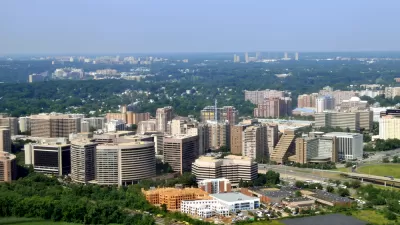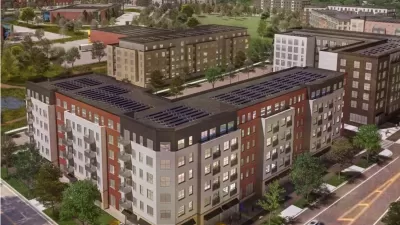A lack of architectural ambition and a focus on car transportation are two of the criticisms that have followed Amazon's initial plans for its second headquarters in Northern Virginia.

Members of the Northern Virginia communities surrounding Amazon’s new headquarters in Pentagon City are pressing for the company's plans to make more room for non-automobile forms of transportation.
"Several dozen residents and community group representatives urged the company to take a stronger stance on pedestrians and public transit during a site plan review at the Aurora Hills Community Center (735 18th Street S.) Tuesday night," according to the article.
The initial plans for Amazon's second headquarters [pdf] have been making the rounds since July, in the form of a site plan for what's now called metropolitan Park. A July article by Vernon Miles describes the plan as "colorful but unambitious."
"Amazon’s proposal involves the construction of two new office buildings at the corner of 15th Street S. and S. Eads Street — almost the perfect midway point between the Pentagon City and Crystal City Metro stations. The project is part of the first phase for Amazon’s permanent offices opening in Arlington," according to Miles back in July.
Fast forward to September, and public engagement has focused on the car-centric nature of the plans under review. "Amazon’s plans for its new headquarters, including an underground parking garage with 1,968 parking spaces, remain unchanged," according to the most recent article. Other car-centric components of the plan are listed as follows:
- A pick-up and drop-off zone for ride hailing services like Uber and Lyft at the intersection of Eads Street and S. Elm Street.
- A drop-off zone for a daycare center in the park, also located on S. Elm Street.
- Street parking for cars along S. Eads Street, 15th Street S., and S. Elm Street.
FULL STORY: Community: Amazon Headquarters Needs Protected Bike Lane, More Buses

Alabama: Trump Terminates Settlements for Black Communities Harmed By Raw Sewage
Trump deemed the landmark civil rights agreement “illegal DEI and environmental justice policy.”

Planetizen Federal Action Tracker
A weekly monitor of how Trump’s orders and actions are impacting planners and planning in America.

The 120 Year Old Tiny Home Villages That Sheltered San Francisco’s Earthquake Refugees
More than a century ago, San Francisco mobilized to house thousands of residents displaced by the 1906 earthquake. Could their strategy offer a model for the present?

In Both Crashes and Crime, Public Transportation is Far Safer than Driving
Contrary to popular assumptions, public transportation has far lower crash and crime rates than automobile travel. For safer communities, improve and encourage transit travel.

Report: Zoning Reforms Should Complement Nashville’s Ambitious Transit Plan
Without reform, restrictive zoning codes will limit the impact of the city’s planned transit expansion and could exclude some of the residents who depend on transit the most.

Judge Orders Release of Frozen IRA, IIJA Funding
The decision is a victory for environmental groups who charged that freezing funds for critical infrastructure and disaster response programs caused “real and irreparable harm” to communities.
Urban Design for Planners 1: Software Tools
This six-course series explores essential urban design concepts using open source software and equips planners with the tools they need to participate fully in the urban design process.
Planning for Universal Design
Learn the tools for implementing Universal Design in planning regulations.
Clanton & Associates, Inc.
Jessamine County Fiscal Court
Institute for Housing and Urban Development Studies (IHS)
City of Grandview
Harvard GSD Executive Education
Toledo-Lucas County Plan Commissions
Salt Lake City
NYU Wagner Graduate School of Public Service





























